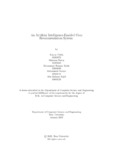| dc.contributor.advisor | Alam, Dr. Md. Ashraful | |
| dc.contributor.author | Uddin, Raiyan | |
| dc.contributor.author | Barua, Mrinmoy | |
| dc.contributor.author | Kabir, Mohammed Hossain | |
| dc.contributor.author | Nufayel, Muhammed | |
| dc.contributor.author | Sajid, Abu Sadman | |
| dc.date.accessioned | 2023-08-27T10:26:41Z | |
| dc.date.available | 2023-08-27T10:26:41Z | |
| dc.date.copyright | 2023 | |
| dc.date.issued | 2023-01 | |
| dc.identifier.other | ID: 18201172 | |
| dc.identifier.other | ID: 18201208 | |
| dc.identifier.other | ID: 19101099 | |
| dc.identifier.other | ID: 19101341 | |
| dc.identifier.other | ID: 19101528 | |
| dc.identifier.uri | http://hdl.handle.net/10361/20014 | |
| dc.description | This thesis is submitted in partial fulfillment of the requirements for the degree of Bachelor of Science in Computer Science and Engineering, 2023. | en_US |
| dc.description | Cataloged from PDF version of thesis. | |
| dc.description | Includes bibliographical references (pages 49-51). | |
| dc.description.abstract | Our country is overburdened with a population of more than 160 million. So fulfilling
the need for food for the whole population can be overwhelming. This research
has been conducted to ensure maximum efficiency in agriculture to overcome this
problem. It is a known fact that Nitrogen (N), Phosphorus (P), and Potassium
(K) are the three most essential micro-nutrients of any soil. Together it is called
N.P.K. Soils also contain Sulfur (S), Zinc (Zn), and Boron (B). Together we can call
it S.Zn.B., which are also important micro-nutrients. Different soils have different
amounts of these essentials. Based on their values, an Automated system can suggest
crops for a particular land to maximize production and profitability. We propose an
AI-enabled crop recommendation system that will determine the best crops based
on the soil type and its N.P.K and S, Zn, and B values through a Machine Learning
Model. In our research, we use a comparative analysis among some existing Machine
Learning Models to identify the most efficient model for our system. This system can
effectively and accurately suggest the best suitable crops for a particular land. We
used Random Forest which gave us 98%, Decision Tree which gave us 98%, Naive
Bayes which gave us 89%, Ensemble Model which gave us 99% of accuracy and
implemented Explainable-AI. As most farmers cannot select suitable crops for their
land following their soil type, the agricultural sector is facing considerable losses.
To minimize this, the efficiency of crop cultivation needs to be increased. Therefore,
our system can revolutionize this sector by providing effective and suitable crops for
land more accurately. | en_US |
| dc.description.statementofresponsibility | Raiyan Uddin | |
| dc.description.statementofresponsibility | Mrinmoy Barua | |
| dc.description.statementofresponsibility | Mohammed Hossain Kabir | |
| dc.description.statementofresponsibility | Muhammed Nufayel | |
| dc.description.statementofresponsibility | Abu Sadman Sajid | |
| dc.format.extent | 51 pages | |
| dc.language.iso | en | en_US |
| dc.publisher | Brac University | en_US |
| dc.rights | Brac University theses are protected by copyright. They may be viewed from this source for any purpose, but reproduction or distribution in any format is prohibited without written permission. | |
| dc.subject | Nitrogen | en_US |
| dc.subject | Phosphorus | en_US |
| dc.subject | Potassium | en_US |
| dc.subject | Sulfur | en_US |
| dc.subject | Zinc | en_US |
| dc.subject | Boron | en_US |
| dc.subject | NPK | en_US |
| dc.subject | SZB | en_US |
| dc.subject.lcsh | Machine learning. | |
| dc.subject.lcsh | Artificial intelligence. | |
| dc.title | An artificial intelligence-enabled crop recommendation system | en_US |
| dc.type | Thesis | en_US |
| dc.contributor.department | Department of Computer Science and Engineering, Brac University | |
| dc.description.degree | B. Computer Science and Engineering | |

